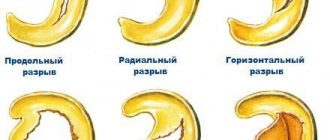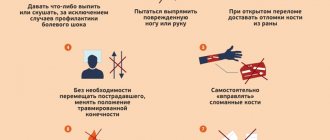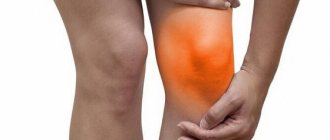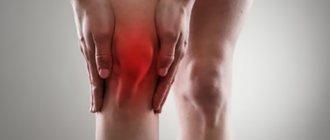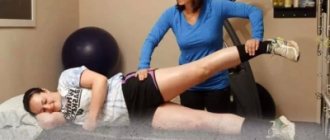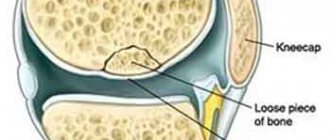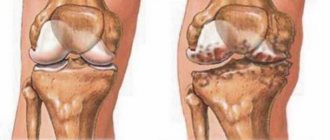Definition and functions of the meniscus Classification of injuries Possible causes of pathology Symptoms of a meniscus tear Degrees of severity of a meniscus tear Diagnosis of a meniscal tear Treatment of a meniscal tear of the knee joint Prevention of a meniscal tear of the knee joint
The knee joint is the most vulnerable part of the human body
, which is exposed to constant trauma and damage in everyday life. One such injury is a torn meniscus of the knee joint.
This closed injury is rarely accompanied by persistent pain.
, and therefore can remain unnoticed for a long time not only by the patient himself, but also by doctors. There are often cases when the victim is simply sent on sick leave with a recommendation not to put any weight on the sore leg.
But a meniscus tear is an insidious disease
, which leads to the development of intra-articular pathologies. It often provokes the appearance of erosions of the joint capsule, arthrosis and other degenerative and inflammatory diseases associated with deterioration of depreciation in the joint.
Young, physically active people between 20 and 40 years old are most susceptible to meniscus injuries, but a tear can occur at any age
. Elderly patients with problem joints are also susceptible to it. Let's figure out how to treat a meniscus tear in young and old people and what complications this condition is fraught with.
A torn meniscus is a common knee injury.
meniscus
meniscus
The joint space of the knee joint contains paired cartilaginous structures called menisci. The lateral (outer) and medial (internal meniscus) are distinguished. They are crescent-shaped and consist of a wider body, anterior and posterior horns. These structures perform important functions; they provide stabilization and shock absorption of the joint.
The outer meniscus is less rigidly fixed; under mechanical stress it can shift, so its damage develops less frequently. The inner meniscus is more rigidly fixed, so it is more easily and often damaged by excessive stress.
Since the horns of the menisci contain a smaller volume of cartilage tissue, a violation of the integrity usually occurs in the area of their localization. A more pronounced mechanical impact can cause damage to the meniscus in the area of the horns and body.
Etiology
Damage to cartilage in the form of a rupture of varying severity occurs due to the influence of various etiological (causal) factors, the most common of which are:
- Previous or acute knee injury that results from excessive flexion of the joint, a blow or fall on the joint, or twisting of the leg (rotation of the hip while the shin is locked). Traumatic changes predominantly occur in young people who lead an active lifestyle or engage in outdoor sports.
- Degenerative-dystrophic changes in cartilage tissue, developing against the background of age-related changes, nutritional disorders (trophism) and leading to a decrease in its strength. This reason often occurs in older people, which is associated with general age-related changes (involution processes).
- Congenital weakening of cartilage structures, caused by changes at the genetic level (the functional activity of genes responsible for the synthesis of the intercellular substance of cartilage tissue changes). Damage to the meniscus in this case develops against the background of normal stress in children or young people.
- Long-term inflammation of the structures of large joints, leading to disruption of their functional state. This etiological factor occurs during the development of an autoimmune pathological process (rheumatoid arthritis, rheumatism), characterized by the formation of autoantibodies by immunocompetent cells that affect their own tissues, mainly the structures of the musculoskeletal system.
Knowledge of the factors that became the main cause of meniscus damage allows a medical specialist to select the optimal rehabilitation, as well as make recommendations regarding the prevention of its development.
Kinds
Kinds
- Partial rupture, in which there is a focal violation of integrity while maintaining the general anatomical structure and shape of the meniscus.
- Complete rupture - a violation of integrity affects the entire thickness of the cartilage, resulting in a fragment that can be displaced relative to other structures of the knee.
To more accurately determine the severity of damage, there is a classification according to Stoller, which distinguishes 4 degrees:
- Grade 0 – no changes.
- Grade 1 – there are small focal changes.
- 2nd degree - more pronounced changes that have a linear shape and do not extend beyond the surface of the cartilage.
- Grade 3 – changes affect the entire thickness of the cartilage, with a complete rupture of the meniscus.
Classification of a tear of the medial meniscus of the knee is possible based on the results of a thorough clinical examination, as well as objective diagnostic data, in particular using MRI (magnetic resonance imaging is necessary for Stoller classification).
Symptoms
Damage to the internal meniscus of the knee in the form of a tear is characterized by the appearance of several main clinical signs:
- Pain localized mainly on the inside of the knee. Its intensity depends on the cause of the injury (after an injury the pain is acute, but during degenerative processes it develops gradually). It increases when trying to perform movements in the knee, as well as against the background of loads on the lower limbs.
- Limitation of mobility with a decrease in the range of movements in the knee, up to complete block, which occurs with a complete rupture of the meniscus, accompanied by a sharp onset of acute pain.
- Inflammatory signs include redness of the skin (redness), swelling of the soft tissue (edema), and increased pain that may be present at rest.
The severity of clinical symptoms depends on the location and severity of the pathological process. With the gradual destruction of cartilage tissue against the background of degenerative-dystrophic processes, signs appear gradually, they can intensify over a fairly long period of time.
Indications for surgery
For what diagnoses is surgery indicated - suturing the meniscus of the knee joint, cutting off the disintegrated edges or its complete removal, inserting a synthetic implant? Common problems requiring corrective surgery include the following types of injuries, confirmed by MRI and radiography:
- separation of a flap (fragment) of the meniscus;
- central longitudinal gap;
- large-scale fragmentation;
- rupture along the periphery with or without displacement.
Types of meniscal tears.
As for the separation of the cartilage flap: here it is urgent to perform surgery on the meniscus of the knee joint; the postoperative period will need to be taken as seriously as possible. If the necessary measures are not taken in time, the free existence of the severed body will impede movement, cause terrible pain and block the knee. The separated fragment, however, like the dangling piece, will begin to create a mechanical obstacle, since during the motor act it will fall into the main working center of the joint.
Schematic representation of the result of suturing the meniscal horn.
Important! It should be clearly understood that the speed and fullness of the return of functional potential subsequently depends on compliance with a special postoperative regimen, and it does not matter what type of manipulation was carried out - correction or removal.
Rehabilitation after surgery on the meniscus of the knee joint is no less significant than the plastic surgery of the functional element itself. Therefore, in no case should you neglect the basic recommendations that will be given by a specialist. Only flawless adherence to a recovery program based on improvement of the ligamentous apparatus and regeneration of the operated area will allow for a quick and successful rehabilitation, as well as avoiding quite dangerous complications.
Conservative therapy
Conservative therapy
Once a medial meniscus tear has been diagnosed, treatment without surgery is prescribed only on the basis of certain criteria, which include the location, characteristics and severity of the damage. The medical specialist must take into account the cause of the pathological condition.
It is usually possible to prescribe conservative measures if small changes have been identified that do not extend beyond the surface of the cartilage. An incomplete meniscal tear can be treated without surgery using medications, physical therapy, and rehabilitation measures. During treatment, the knee is provided with functional rest, which is achieved by immobilization (immobilization) using tight bandages or a plaster splint.
Signs during hardware diagnostics
An acute rupture of the posterior horn of the medial meniscus during arthroscopy can be distinguished from a chronic (old) or degenerative one by the condition of the cartilage and fluid. A “fresh” tear has smooth edges, no fibering, there is an accumulation of blood (hemarthrosis), and in a chronic tear, the cartilage is fibered, there is swelling from the accumulation of synovial fluid, and the nearby bone cartilage is often damaged.
Meniscus tear on MRI (image in the sagittal plane): if both cartilages normally have the shape of a butterfly (bow), then any change in this shape suggests a meniscus tear. The appearance of an “extra” ligament should also alert you.
Drug treatment
Medicines, their dosage and regimen of use are determined by a medical specialist individually for each patient, necessarily taking into account various factors, such as the person’s age, gender, location and severity of damage. Drug therapy primarily includes the use of drugs from several pharmacological groups:
- Non-steroidal anti-inflammatory drugs - drugs are used to reduce the severity of inflammation of moderate intensity. Usually tablet or injectable dosage forms are prescribed in combination with drugs for external use (cream or ointment).
- Glucocorticosteroids are hormonal drugs that are prescribed for severe long-term inflammation, in particular against the background of an autoimmune reaction.
- Chondroprotectors are a group of drugs that reduce the rate of destruction of cartilage tissue and also promote its restoration.
- Vitamins - allow you to speed up the process of tissue regeneration, as well as improve the general condition of the patient.
As an alternative method of conservative therapy, intra-articular administration of platelet mass (a biological preparation that is a suspension of platelets in physiological solution) is possible. It contains biologically active compounds “growth factors” that stimulate regeneration processes in cartilage and connective tissue.
First aid
When a meniscus ruptures, the pain is so severe that the victim cannot put weight on his foot. He needs help getting to bed, laying him down, raising the injured leg by placing a bolster or pillow under his shin. You should not try to straighten a blocked joint, as this can cause even greater damage. It is necessary to fix the joint with a splint, a removable splint, or apply an elastic bandage that does not compress the skin too much.
To relieve inflammatory swelling and eliminate pain, apply an ice pack wrapped in thick cloth to your knee every hour for 10 minutes. Any non-steroidal anti-inflammatory drug (NSAID) can be used as analgesics - Ketorol, Nise, Diclofenac, Nurofen tablets.
Physiotherapeutic procedures
Physiotherapy involves the use of various physical factors that reduce the severity of inflammatory, degenerative-dystrophic processes, and also promote faster tissue restoration. For this, depending on the severity of the pathological process and the technical capabilities of the medical institution, the following can be used:
- ozokerite;
- mud baths;
- electrophoresis with various anti-inflammatory drugs.
The duration of use of physiotherapeutic procedures is determined individually by a medical specialist. They are usually combined with drug treatment.
Rehabilitation
Rehabilitation
Carrying out rehabilitation measures is no less important than the main course of treatment. It involves resting the knee immediately after surgery or conservative therapy, followed by special activities that involve certain movements.
As the tissues recover, the range of motion and load gradually increase. This makes it possible for the cartilage tissue to adapt to loads and subsequently restore the functional state of the knee.
physical therapy complex
complex of physical therapy
After the basic therapeutic course, restorative procedures and measures are prescribed. They involve special physical training in a physical therapy complex (PT). In this case, the load on the knee increases in stages, and this allows the cartilage structures to adapt to it in order to avoid repeated damage.
Due to the fact that the joint is in a state of functional rest for quite a long time, there is a risk of developing contractures (connective tissue adhesions), so rehabilitation with exercises is necessary to prevent the development of this complication. The duration of the course of such measures depends on the type of treatment performed, as well as on the severity of the damage. Typically it varies over a period of time from several months to six months.
REVISION OF MRI OF THE KNEE JOINT
As we can see, MRI is a very valuable method, but much depends on the qualifications of the specialist analyzing the research results. In the absence of proper experience, the doctor may misinterpret what he sees and make a mistake. Therefore, if the diagnosis remains open or is in doubt, you can always get a second opinion and contact another specialist of a higher profile to obtain a second opinion. Such consultation can be obtained using NTRS, a remote MRI consultation system that collaborates with experienced diagnosticians from the Military Medical Academy and other large specialized institutions.
